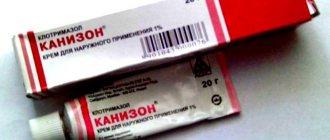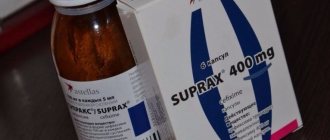- October 13, 2018
- Rheumatology
- Bolshakova Yulia
This drug is used for joint or muscle pain. The active component in Diclofenac ointment has anti-inflammatory and analgesic properties. It works quite quickly and effectively. In addition, the ointment has virtually no contraindications or side effects and is well tolerated by the patient.
pharmachologic effect
Diclofenac has anti-inflammatory, analgesic and decongestant effects due to inhibition of the synthesis of prostaglandins, which play a major role in the pathogenesis of inflammation. For rheumatic diseases, it reduces pain in the joints at rest and during movement, as well as morning stiffness and swelling of the joints, and helps to increase range of motion. When applied externally, diclofenac penetrates the skin and accumulates in the underlying tissues (subcutaneous tissue, muscle tissue, joint capsule and joint cavity).
Main characteristics of Diclofenac ointment
Diclofenac ointment is a non-steroidal anti-inflammatory drug that quickly relieves pain and has mild therapeutic properties. Intended (according to official instructions) for the treatment of joint diseases and alleviation of injuries to soft tissues and bones.
| Release form | Ointment 1%, gel 5% |
| Composition of the drug | The main active ingredient is diclofenac sodium, auxiliary ingredients are dimexide, lavender extract, the remaining components have no therapeutic value |
| Effect | Analgesic, anti-inflammatory, weak immune-strengthening |
| Application in pediatric practice | Up to 6 years of age it is extremely undesirable; from 6 to 12 years of age the dosage should be halved |
| Shelf life | 24 months from date of issue |
| Cost of the drug | from 21 rubles |
Compound
The main active ingredient with a pronounced analgesic effect is diclofenac sodium. Dimexide (has anti-inflammatory and antimicrobial properties) and lavender extract (soothe the skin, relieves redness and irritation) are used as additional ingredients. The composition also contains:
- propylene glycol;
- purified water.
These components do not have therapeutic effects and are needed only as binding elements.
We recommend reading about how to choose an ointment for bruises. From the article you will learn why and how to use ointment for a bruise, recommendations for use, contraindications. And here is more information about how to choose an ointment for joints depending on the pathology.
Drug group
Diclofenac ointment belongs to the group of non-steroidal anti-inflammatory drugs, which are not hormones, and therefore can be used in the treatment of patients of almost any age.
Drugs from this group are most often used in the treatment of diseases of the musculoskeletal system, inflammatory soft tissues, and alleviate the patient’s condition in case of injuries.
Mechanism of action
The ointment significantly reduces pain in the area of the inflamed joint or damaged soft tissue. Relief for the patient comes quickly, he is able to move without pain, continue to lead an active lifestyle, and swelling in the area where the drug is used is significantly reduced.
Diclofenac ointment or gel has the stated effect regardless of the place of application:
- with cervical osteochondrosis, the ability to freely rotate the head is restored, and the usual headaches are not bothered;
- if there are problems with the lower back, return the patient to an upright position;
- the ankle joint begins to move efficiently, the person can resume walking.
It is worth knowing that Diclofenac ointment perfectly relieves pain, inflammation and swelling, but does not have a full therapeutic effect. Therefore, the drug is never used as the only treatment, but is actively used to relieve symptoms.
Diclofenac gel and ointment: method of application
Diclofenac gel, like ointment, is applied to previously cleansed skin at the site of inflammation or injury. It is believed that you need to lightly rub the drug into the skin and massage it, but this recommendation only applies to the ointment, since the gel is quickly absorbed.
Some doctors advise placing a bandage on top of the treated area - this will facilitate more complete penetration of the drug directly to the pathological focus and prevent the ointment/gel from coming into contact with air, which can reduce their effectiveness.
Analogs
Analogues of diclofenac ointment are conventionally divided into pharmaceutical preparations with the same active ingredient and similar non-steroidal drugs.
- Direct analogues: “Naklofen”, “Voltaren”, “Diklak”, “Ortofen”.
- Similar products: Naproxen, Meloxicam, Indomethacin, Nise gel.
Only the doctor selects a substitute based on the optimal form of the drug and a general assessment of the patient’s condition and the presence of contraindications.
We recommend
Detailed review, instructions for use Indomethacin ointment.
Properties ↑
It is not for nothing that this drug is classified as a non-steroidal anti-inflammatory drug, because it has a clear anti-inflammatory effect.
Due to the fact that it contains certain analgesic substances, it also has a rapid analgesic effect at the sites of application.
This drug quickly relieves pain and prevents swelling in the affected joints. In addition, the use of ointment can significantly increase their mobility.
Compared to other products, diclofenac ointment has a number of advantages:
- absorbs quite quickly and does not leave any greasy shine/stains on clothes;
- the drug has good penetrating ability;
- has a transdermal effect.
Read also…. Meloxicam tablets and injections - reviews of effectiveness
Can Diclofenac be used for children?
In childhood, Diclofenac can be used in the treatment of diseases of the musculoskeletal system and muscle fibers, but not before the patient reaches the age of 6 years. Then, until the 12th birthday, the child can use the ointment to alleviate the condition, but the single dosage should be half that for an adult - only 2 g of the drug (the size of a pea) is enough for one use.
Is it suitable for pregnancy and lactation?
While carrying a child and breastfeeding, the use of Diclofenac ointment is strictly prohibited. No studies have been conducted on the effect of this non-steroidal anti-inflammatory drug on the development of the fetus and the already born child.
Doctors can make an exception, but only if the risk of deterioration in the mother's health is higher than the risk of disturbances in the intrauterine development of the fetus.
Is it possible if you have kidney or liver problems?
A history of kidney and liver diseases may be a contraindication to the use of Diclofenac ointment in therapy, but only if the pathologies are severe and characterized by frequent relapses.
What does Diclofenac ointment help with?
Diclofenac ointment helps to quickly relieve pain and swelling, so the indications for use are:
- diseases of the joints and muscles such as sciatica, lumbago, radiculitis, arthritis, accompanied by severe pain and swelling;
- contusions, bruises/hematomas, sprains, inflammatory processes in soft tissues and other pathologies of muscle tissue of rheumatic and non-rheumatic origin;
- inflammatory diseases of ligaments, tendons;
- bursitis, tendovaginitis;
- pathological processes localized in periarticular tissues.
Diclofenac ointment solves the problem of pain, swelling and inflammation in the back (along the entire length of the spinal column). But it is important to understand that this drug only relieves obsessive, unpleasant symptoms, so a full therapeutic course will need to be carried out separately.
Using Diclofenac ointment for a long time is strictly prohibited - the body may become addicted, and the likelihood of developing a myocardial infarction increases by 40%.
Directions for use and dosage
Diclofenac ointment is used only externally and locally - it is used to treat the site of progression of the pathology or the point of severe pain. Typically apply about 2-4 g (the size of a pea or small cherry) 2-3 times daily depending on the problem.
Sprains and radiculitis
Apply a thin layer of ointment to the problem area 3 times a day. For one application you will need an amount of the drug equal to a small cherry - about 4 g. The drug should be well distributed over the surface of the epidermis, this can be done with massage movements (circular, rubbing).
For radiculitis, it is recommended to cover the pathological lesion with a bandage made of warm material after applying the drug. Warming up in this case will only speed up the process of restoring mobility.
Osteochondrosis of any part of the spine
A small amount of ointment should be applied to the site of pain and spread in a thin layer over the epidermis. The manipulation cannot be carried out more than 2 times a day. Already on the first day the patient will experience relief, but it is recommended to continue use for another 2-3 days.
Even if osteochondrosis is accompanied by progressive osteoporosis, Diclofenac ointment can be used - it does not further increase the level of bone fragility.
Bruises, soft tissue injuries, bruises
The ointment is applied to the problem area 3 times a day in a thin layer. For one-time use, an amount of the drug equal in size to a pea is sufficient. You cannot apply a bandage - this can provoke active spread of inflammation and an increase in the area of swelling.
The duration of the course of use of the drug is 14 days, but it is recommended to discontinue it immediately after the onset of relief and the disappearance of severe pain.
Watch this video about the mechanism of action and use of Diclofenac ointment:
Contraindications for use
The ointment should not be used even if there are direct indications for:
- rhinitis (runny nose) of various origins, occurring in the acute stage;
- bronchial asthma, when attacks are recorded frequently;
- gastric/duodenal ulcer.
It is strictly forbidden to use the drug if there is damage to the skin (at the intended application sites).
Side effects
If Diclofenac ointment is used strictly as directed and within the recommended dosages, then no side effects will be observed. But if the instructions are violated, the following are possible:
- excessive irritability of the patient, nervous excitability;
- persistent nausea, which necessarily ends with vomiting;
- severe headaches accompanied by dizziness;
- intestinal disorder - diarrhea;
- cramps disturbing in the lower extremities;
- pain in the abdomen, the area of the anatomical location of the stomach (epigastric);
- dysfunction of the liver and kidneys.
An extremely rare side effect is the development of internal bleeding in the gastrointestinal tract.
What drugs does it combine with?
Diclofenac in the form of ointment and gel can be combined with any other medications. But if other medications from the group of non-steroidal anti-inflammatory drugs are used in therapy simultaneously with the external agent, the likelihood of developing side effects significantly increases.
special instructions
The official instructions strictly indicate the following nuances:
- if possible, it is better not to treat children with Diclofenac ointment; the doctor should select another drug with an identical effect;
- per day for an adult the dose should not exceed 8 g;
- if there is a history of heart and vascular diseases, then Diclofenac ointment should be prescribed only by a doctor.
Diclofenac ointment
Use during pregnancy and lactation
Like any medicine, ointments with diclofenac sodium are highly not recommended for use in the first and last trimesters. These drugs can significantly weaken labor and harm the baby. They have a fairly high degree of permeability and are carried by blood to all organs.
During breastfeeding, this drug is usually not prescribed. However, doctors can prescribe Diclofenac if the benefits of the ointment outweigh the theoretically possible risk to the child’s health. The instructions for Diclofenac ointment indicate this. Before use and immediately after it, the mother should wash her hands thoroughly and cover the area where the cream is applied with cling film and cloth. Do not allow the product to come into contact with the baby.
Reviews
Artyom, Kirov
Ointment is very cheap and quite effective. The first time they prescribed it to me was in the emergency room. While it’s working, it doesn’t hurt and doesn’t swell that much. It’s a pity that you can’t smear it more than 3 times a day.
Zhanna, Severobaykalsk The bruise was so large that the leg was swollen and did not fit well into the shoes. Diclofenac worked wonders - the shoes were put on. Of course, I had to apply it 3 times a day, because after a while the pain and swelling returned. But in general, with this ointment I was able to “pass” the time after the injury in regular shoes, without purchasing any other shoes.
Zoya, Kazan Since I found out the ointment, I stopped using tablets. I apply it to my knee when there is severe pain, and I feel much better than before.
Diclofenac ointment or gel - which is better?
Depending on what health problem needs to be solved, it is determined what is better to use in a particular case - Diclofenac ointment or gel. The latter option differs from the ointment in the following properties:
- has a higher concentration of the main active ingredient (5%);
- is absorbed almost instantly and quickly reaches the pathological focus due to its structure;
- Contains lavender oil, which has calming and mild anti-inflammatory effects.
It is advisable to use Diclofenac gel not for the treatment of diseases of the musculoskeletal system, but for quick relief from muscle pain. Indications for use of the drug:
- pain in muscle fibers, regardless of the cause;
- sprained ligaments - for example, when twisting the ankle joint or improperly performing the process of lifting weights;
- swelling of muscle fibers that occurs against the background of progression of sciatica, arthritis, lumbago and arthrosis.
Diclofenac gel
Prices and conditions for dispensing from pharmacies
The medicine is available in pharmacies without a prescription and is freely sold in online pharmacies. The cost of the medication varies from 30 to 80 rubles. Some analogues are cheaper than ointments (see below), but their mechanism of action on problem areas differs from that discussed above.
Average prices for diclofenac ointment in Russia:
- 30 g tube (2% composition), produced by Zelenaya Dubrava – from 25 rubles;
- Gel 5% in an aluminum tube of 50 (30) g, produced by Sintez AKOMP - from 75 rubles. (65 rub.);
- Ointment 1% in a 30 g tube, produced by Ozone - from 30 rubles.
The cost of the drug is one of the most affordable among similar medications.
Contraindications ↑
Diclofenac, like most medications, has certain contraindications.
These include:
- hypersensitivity to the active substance diclofenac, as well as acetylsalicylic acid, which is part of this ointment or other additional anti-inflammatory non-steroidal drugs;
- bronchial asthma;
- rhinitis;
- stomach or duodenal ulcer during an exacerbation;
- pregnancy, as well as lactation period.
- children under 6 years of age.
Are you experiencing joint pain? Perhaps these are symptoms of salt deposition in the joints.
Do you suffer from spondylosis deformans? Find out more about the disease here.
Is it possible to overdose the drug? ↑
As is known, when this ointment is used externally, an overdose in humans is unlikely.
However, when applying Diclofenac ointment to large areas of the body and using it for too long, the possibility of side effects of the drug cannot be completely excluded.
The clinical picture, as a rule, is determined by disorders that manifest themselves in the central nervous system.
Read also…. Celecoxib - instructions and recommendations for use
In case of overdose, the following symptoms are possible:
- headache;
- sudden dizziness;
- increased excitability;
- symptoms of hyperventilation with slightly increased convulsions;
- In children, overdose quite often manifests itself in the form of myoclonic convulsions.
From the gastrointestinal tract, an overdose is manifested by the following disorders:
- abdominal pain;
- nausea;
- vomiting.
Bleeding from the gastric or intestinal tract may also begin and general liver/kidney dysfunction may occur.
If the listed symptoms of overdose appear, you should consult a doctor and immediately stop using the ointment.
Side effects ↑
When using this drug, some of the side effects that occur directly depend on:
- individual characteristics of a person;
- sensitivity to the drug;
- dose size;
- total duration of treatment.
As a rule, side effects manifest themselves as local reactions: allergic manifestations on the skin are possible (skin rash, burning sensation, slight redness).
If this ointment is used for too long and/or when used in large doses, serious adverse systemic symptoms may occur:
- from the gastric and intestinal tract: pain in the epigastric zone, nausea, loss of appetite, flatulence;
- from the central nervous system: headaches, excessive drowsiness, frequent dizziness;
- from the respiratory organs: anaphylactic systemic reactions, bronchospasm, including life-threatening anaphylactic shock.
If side effects occur, you should stop using this ointment and consult a doctor as soon as possible.










